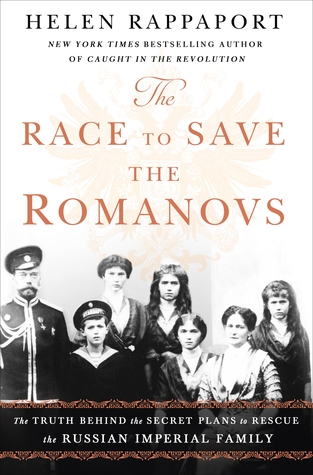by Helen Rappaport
St. Martin’s Press, 2018
In her book The Race To Save The Romanovs Helen Rappaport pulls from previously unseen documents to present the true, and harrowing story behind the secret plans to save the Russian Imperial family in the wake of the the abdication of Tsar Nicholas II, and the Bolshevik Revolution. The Race To Save The Romanovs focuses on a very specific time period, from the Tsar’s abdication in March of 1917 through till the barbaric slaughter of the Tsar and his family in July of 1918.
King George V is often scapegoated as the reason for the failed rescue of the Romanovs. However, just like most events in history, the truth behind the failed attempts to save the Russian Imperial family cannot be boiled down to a simple soundbite. When the geography of Russia is taken into account alone, a myriad of problems can arise, the challenge of simply coordinating a route would have been nightmarish enough, without the threat of Bolshivik marauders hidden in every village along the way. Rescues by air and by sea were both contemplated, however, ice was an issue for ships, and the best plays available didn’t have the ability to fly the distance on a single flueing, or had the passenger capacity to carry all seven members of the Romanov family.
The Race To Save The Romanovs begins with a summary of the familiar tensions widely prevalent among the Royal families of Europe particularly between Germany, England, and Russian, as well as mounting political tensions emanating from both Russia and the West, laying the groundwork for World War I. The relationships between Kaiser Whilhelm II and Alexandra played an important role in the Romanov rescue drama, as did the relationship between King George V and his cousin Nicholas II.
One of the most interesting aspects of the Romanov rescue story is the involvement of King George V. Growing up, George and Nicholas were incredibly close. They were strikingly similar in appearance, often called “the heavenly twins.” As darkness fell over the Russian Monarchy, King George had to battle against his pull to help a dear cousin, or to act as the head of his country. “King George’s reign had, since the outbreak of war in 1914, already witnessed a darkening atmosphere of strikes and industrial unrest, fuelled by the growth of support for socialism and the rise of the Labour Party. Socialism had brought with it the much feared spectre of republicanism, and King George was only too acutely aware that his government’s priority was to hold the Home Front together all the time there was a war going on. He dreaded the onrush of a class war in Britain mimicking that in Russia; his cousin Nicholas’s fall from power posed a serious conflict of interests over which he dithered and agonsied as he tried to balance his private familia sympathies with his duty as head of the nation.”
While the British government discussed ways of getting the Romanovs out of Russia, they lacked the motivation to save the Imperial family. Because of World War I, and England’s long history of Russian rivalry, the general public was not in favor of housing the Russian Imperial family. King George V sent private messages to Nicholas II offering his sympathies, and possibly ways he could assist his cousin, but lacking the power to make discussions for himself, King George V was unable to get his government to comply.
Meanwhile, the German Kaiser tried to balance his role as protector of his country, and taking care of Alxendra and her family, as the Tsarina was German by birth. However, given his country’s allegiance during the war, opening his county up to the Russian Imperial family wasn’t an option as far as his government was concerned. The kings of Spain, Belgium, Bulgaria, Italy among others added their countries to the list of those struggling to help remove the Romanovs from Russia, passion and purpose were rampant among those working to save Nicholas and his family, every plan hit one of several walls. Either Russian geography posed too many problems, or the issue of the war looming over Europe put a stop to all their rescue missions. After Tsar Nicholas’s abdication, a Provisional Government was set in place until further governmental elections could be held, in the meantime, “The British could not risk compromising Russia’s new Provisional Government – their wartime ally.” Russia was incredibly volatile, and King George V found himself, and his government walking on eggshells during their negotiations to organize a Romanov rescue.
Rappaport weaves much of the Romanov correspondence, and journal entries into her book, crafting a deeply emotional and tragically heartbreaking narrative. Towards their final days, an eerie peace had settled over the Russian Imperial family. When provided with their final service, Father Ivan Storozhev, a local priest, recalled, “he had been deeply moved by their devotion and the enormous comfort they had clearly taken in being allowed to worship together.” However, he also would remember with a chill the “…eerie sense of doom that had prevailed through the singing of the liturgy, it was almost as though the family had been sharing, knowingly in their own last rites.”
Race To Save The Romanovs provides its readers with a stirring, and deeply moving narrative, Helen Rappaport’s control over the subject is evident through her meticulous research and elegant writing. The Race To Save The Romanovs requires no previous knowledge of the subject matter for its reader to be deeply swept away by its narrative, and affected by its story.
